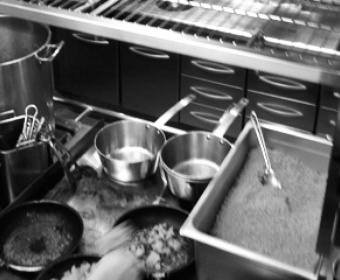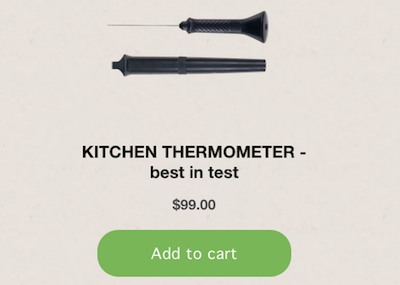
Cooking fish like a pro
- Better undercook than overcook
- Use a thermometer
- Don’t boil – simmer
- Fry at a reasonable temperature – then turn it down
- Only firm fish and shellfish on the grill
Fish and shellfish protein is fragile. It starts to denature – coagulate – at 40°C. The interval within which the flesh is most succulent and tastes best is small too and the cooking time is short. Cook it for too long and the flesh goes floury and loses its elasticity. This means it’s important to keep a sharp eye on times and temperatures.
Internal temperatures for fish:
There’s not much room for maneuver but different types of fish need to reach different internal temperatures when you’re cooking them:
• White fish, e.g. cod, monkfish, A. wolffish: 52° C
• Halibut: 48 – 50° C°
• Flatfish: 50 – 52° C
• Monkfish: 47 – 58° C
• Salmon: 48 – 52° C
• Sharks: 52° C
• Tuna: 31° C - raw center
• Eel: 70° C
• Pilgrim mussels: 45°C
• Lobster: 45° C
• Mussels, oysters: When the shell (previously closed) opens
Use a thermometer
Fish flesh is usually done within a range of only 4–5°C (see above). A digital thermometer is the best piece of equipment for guaranteeing a perfect result. Most professional ovens include a thermometer.
A good thermometer is quick and has a thin probe which means you damage the delicate flesh as little as possible. Push the thermometer into the middle of the thickest part of the fish or fillet.
Factor in the residual heat
If you’re aiming at an internal temperature of 50°C, stop cooking a few degrees earlier because the temperature will keep rising once the fish has been removed from the heat. Fish flesh is delicate and contains a lot of water and can quickly become overcooked and dreary.
A thermometer is recommended but you can also test the flesh with a fork. If it goes through the flesh easily, without any resistance, the fish is ready. With whole fish you can test – with a fork or your finger – whether the flesh comes away from the backbone easily.
Low temperature
You can cook an entire piece of fish at the inner temperature you want to attain, e.g. sous vide or in an oven set to 50° C. It heats up so slowly and so gently that the appearance of the flesh doesn’t undergo as great a change. With this method, the fish flesh might look raw even though it is completely cooked, which means a calibrated thermometer is a must.
Medium temperature
Slow cooking, e.g. in an oven at a temperature of 90°C to 125°C also produces an even and moist result. The outer layers of flesh and the center are exposed to roughly the same heat, resulting in an even consistency. When you stop cooking, there’s minimal residual heat, a couple of degrees max.
High temperature
If you cook fish at 175°C or more, you get an uneven result. The outside of the fish is done more quickly than the middle. And the heat continues to spread inwards into the flesh long after you have removed the fish from the heat. If you’re cooking it the oven, you can take 4% of the oven temperature as a guideline for how big the increase will be. (i.e 8°C if your oven is operating at 200°C.)
Appearance of the flesh
One way of checking whether fish is done is to look at the appearance and color of the flesh:
• White fish isn’t done if the flesh is transparent and stuck together.
• White fish is done and still moist when there’s a bit in the middle that is slightly transparent, like mother of pearl.
• Overcooked white fish is white all the way through, dry and stringy.
• The red flesh in game fish is done when it is pale pink and firm without being dry.
• The flesh of fish in the tuna family can be cooked according to roughly the same scale as red meat. It must not be dry – done – all the way through.
Quicker means whiter
The quicker (hotter) you cook fish, the whiter and more opaque it becomes. If, for example, you cook fish at just 52°C for a long time, it almost looks raw despite being done all the way through.
“Big pieces are generally better than little ones.”
– Per Renhed, former chef at F12
Lean fish
When cooking lean, white fish, it’s worth considering mild and/or fatty dishes. Mild ingredients match the delicate flavor of the white flesh. And these flavors get a boost from the fat in coatings or breadcrumbs.
Boiled lean fish becomes a more fun experience with added fat, melted butter being perhaps the best as well as the easiest option.
Fatty fish
Fatty fish are often easier to handle than lean fish and can better withstand high temperatures. Fatty fish work well fried or grilled.
About protein:
What happens at molecular level when you cook fish is that the protein fibers coagulate, they attach to each other, pull together and form a solid mass that also contains water molecules. All protein coagulates between 40°C and 60°C and fish protein is particularly fragile.
Fish and shellfish are coldblooded – their bodies maintain the same temperature as the surrounding water. Most also live in cold water which means that the protein is even more fragile and dries out at even lower temperatures than the flesh of warm-blooded animals that live on land. The range for coagulation is between about 45°C and 55°C.
If the heat continues to rise beyond the coagulation point, the proteins are pulled together even more. The mass becomes denser and harder and the water is squeezed out. The fish becomes dry and grainy. The coagulation of proteins is an irreversible process, once it has happened, you can’t undo it. This is why it’s better to cook fish too little than too much.
When you fry or grill fish, two things happen to the surface – caramelization and the Maillard reaction. The flesh is mainly protein, but small amounts of sugar caramelize on the surface, making it separate from the rest. The chemical process known as the Maillard reaction happens between carbohydrates and amino acids, causing a brown color and a large number of subtle flavors and aromas.
If the fish in your frying pan releases so much liquid that it boils, the Maillard reaction doesn’t happen. Water boils at 100°C, which is too low to create the aromas and flavors that come about from grilling and frying at temperatures above 120°C.



